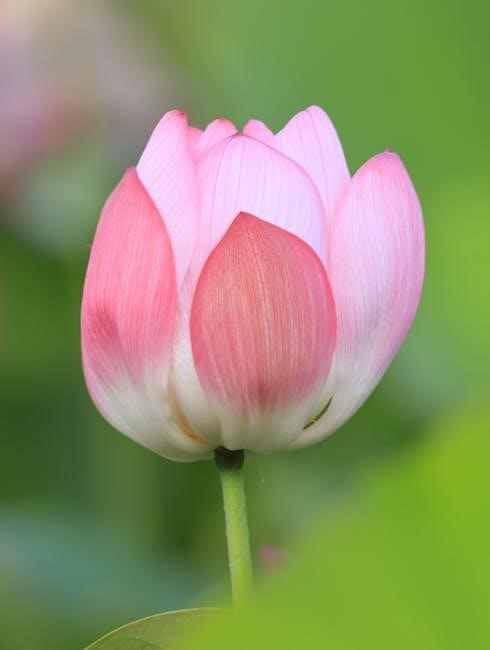The origami lotus flower is a timeless symbol of purity and renewal. This traditional origami model is celebrated for its beauty and cultural significance, making it a popular choice for artists and beginners alike.
What is an Origami Lotus Flower?
The origami lotus flower is a traditional paper folding design that represents the symbolic lotus, often associated with purity, renewal, and spiritual growth. This model, typically crafted from a single square sheet of paper, captures the elegance of the natural lotus bloom. It is characterized by its layered petals and a central core, mimicking the real flower’s structure. The origami lotus is a popular choice for both beginners and experienced artists due to its simplicity and profound meaning. Unlike other origami flowers, the lotus carries cultural and spiritual significance, making it a cherished creation in the world of paper art. Its beauty and symbolism have made it a timeless favorite among origami enthusiasts worldwide.

Significance of the Lotus Flower in Origami
The lotus flower holds profound cultural and spiritual significance, making it a revered subject in origami. Symbolizing purity, resilience, and enlightenment, the lotus represents the journey from darkness to light, as it grows in muddy waters yet blooms untainted. In many Eastern cultures, it embodies spiritual awakening and renewal. The origami lotus captures these themes, serving as a meditative and artistic expression. Its creation is often seen as a reflection of patience and dedication, mirroring the flower’s natural growth process. Beyond its aesthetic appeal, the origami lotus carries a deeper meaning, connecting creators and admirers to timeless philosophical ideals. This symbolism has cemented its place as one of the most cherished origami designs, transcending mere craft to convey profound existential truths.
Why Choose the Lotus Flower for Origami?
The lotus flower is a compelling choice for origami due to its elegant design and symbolic depth. Its layered petals and intricate structure offer a rewarding challenge for creators, making it a popular model for both beginners and experienced artists. The lotus’s universal appeal lies in its simplicity and beauty, allowing it to be adapted into various origami styles. Additionally, the process of folding a lotus mirrors its natural growth, providing a meditative and fulfilling experience. With its rich cultural significance and aesthetic charm, the origami lotus remains a timeless and inspiring project. Its versatility also makes it suitable for decorations, gifts, and personal enjoyment, further enhancing its appeal as a beloved origami subject.
Materials Needed for Origami Lotus Flower
A square sheet of paper is essential for creating an origami lotus flower. Choose paper with vibrant colors on one side for a striking appearance. Pliers or a bone folder can help create sharp creases, ensuring precise folds. A flat, clean workspace is also crucial for accurately following the folding instructions. Avoid using too-thick paper, as it may complicate the folding process. With these simple materials, you can craft a beautiful and intricate origami lotus flower that captures the elegance of the natural bloom.
Choosing the Right Paper for the Lotus Flower

Selecting the appropriate paper is crucial for crafting a beautiful origami lotus flower. Opt for square paper, as it is traditionally used in origami and ensures symmetry; The size of the paper will determine the size of the final flower; larger sheets are easier for beginners to handle. Choose paper with vibrant colors or patterns, as this will enhance the visual appeal of the lotus. Double-sided paper is ideal, allowing you to showcase contrasting colors for the petals and center. Avoid thick or textured paper, as it may complicate folding. For a more authentic look, use origami-specific paper, such as kami or washi, which is designed for precise folds. The right paper will make the folding process smoother and the final result more stunning.
Tools Required for Folding the Lotus Flower

To successfully create an origami lotus flower, you will need a few essential tools. A flat, stable workspace is crucial for precise folding. A ruler or bone folder can help create sharp creases, ensuring clean folds. Scissors may be necessary for trimming paper to the desired size. A pencil can mark folding lines for better accuracy. Optional tools include tweezers for delicate adjustments and a small spray bottle to slightly dampen the paper, making it more pliable. These tools enhance your ability to achieve intricate details and maintain the flower’s structure. Having the right tools on hand will make the folding process smoother and more enjoyable, allowing you to focus on crafting a stunning origami lotus flower.
Preparing the Workspace for Folding
Setting up a proper workspace is essential for creating an origami lotus flower. Begin by clearing a flat, stable surface, such as a table or desk, to ensure your paper remains steady during folding. Good lighting is crucial to see details clearly, so position yourself near a natural light source or use a desk lamp. Gather all necessary tools, like a ruler or bone folder, and place them within easy reach. A clean, uncluttered environment will help you stay focused. Consider using a non-slip mat or cloth to prevent the paper from sliding. Optional items include a small spray bottle for dampening the paper or a reference guide for quick checks. A well-prepared workspace minimizes distractions and allows you to concentrate on the intricate folds required for the lotus flower, ensuring a smooth and enjoyable folding experience.

Understanding the Basics of Origami Folding
Origami basics involve essential folds like the valley fold, mountain fold, and petal fold. These foundational techniques are crucial for creating intricate designs like the lotus flower.
Basic Origami Folds Every Beginner Should Know
Mastering basic origami folds is essential for creating intricate designs like the lotus flower. The valley fold, which creates a crease by folding paper in half and unfolding it, is fundamental. The mountain fold, its counterpart, involves folding the paper in the opposite direction to form a peak. The petal fold is another key technique, used to create layered, curved shapes, commonly seen in flower designs. Additionally, the square and diagonal folds help in aligning and proportioning the paper. These foundational folds, when practiced, provide the skills necessary to tackle more complex models, including the origami lotus flower. Precision and patience are vital in executing these folds correctly.
Importance of Precision in Origami Folding
Precision is crucial in origami folding, especially when creating intricate designs like the lotus flower. Even the slightest misalignment can affect the final result, making it essential to follow each step carefully. Sharp creases and accurate folds ensure the model holds its shape and maintains symmetry. Without precision, the delicate petals and layers of the lotus may not form correctly, leading to a less-than-desired outcome. By taking the time to make precise folds, you ensure the beauty and integrity of the origami lotus flower are preserved. This attention to detail not only enhances the aesthetic appeal but also makes the process more rewarding and fulfilling for the creator.
Common Mistakes to Avoid in Origami
When creating an origami lotus flower, several common mistakes can hinder the process. One of the most frequent errors is using paper of the wrong size or type, which can make folding difficult and affect the final shape. Another mistake is failing to crease folds sharply, leading to a lack of definition in the petals and layers. Additionally, some individuals rush through the folding sequence, causing misalignment and asymmetry in the design. It’s also important to avoid applying too much force, as this can tear the paper or distort the model. By being mindful of these pitfalls and taking a patient, meticulous approach, you can achieve a more precise and visually appealing origami lotus flower.

Step-by-Step Folding Instructions for the Lotus Flower
Fold the top flap down and the corners inward to form the base. Layer the petals by folding and unfolding, then shape outward for the bloom.
Folding the Initial Square Base
Begin by folding the paper in half diagonally to create a triangle, then unfold it to form a crease. Fold the paper in half again, this time along the other diagonal, creating an “X” crease. Next, fold the top right and left corners down to the center crease, forming a smaller triangle. Turn the paper over and repeat the process on the other side to ensure symmetry. Finally, fold the bottom corner up to the center, creating a square base. This step is crucial as it lays the foundation for the lotus flower’s layers and petals. Ensure all folds are crisp and precise, as this will affect the overall shape and symmetry of the final model. A well-crafted base ensures the lotus flower will bloom realistically.
Creating the Lotus Petals
After forming the square base, fold the top and bottom corners to the center crease, creating triangular flaps. Next, fold the sides inward, aligning the edges with the center line. This forms the initial layers of the lotus petals. Fold the top layer back and then forward, creating a petal-like shape. Repeat this process on the opposite side to mirror the design. Continue folding and layering the paper to build the petal structure, ensuring each fold is crisp and symmetrical. As you progress, the petals will begin to take shape, forming the iconic lotus bloom. Be patient, as precise folding is key to achieving the delicate, layered appearance of the lotus flower.
Forming the Lotus Center
Start by folding the square base in half diagonally to create a crease. Open it and fold the top and bottom corners to the center crease, forming a smaller square. Fold the sides inward, aligning the edges with the center line. This creates a compact center for the lotus. Fold the triangular flaps upward and tuck them under the layers to secure the center. Repeat this process to reinforce the structure. The center should be tight and symmetrical, as it holds the petals in place. Adjust the layers gently to ensure the center is even and firm. This step requires patience and precision to achieve the desired shape. A well-formed center ensures the lotus petals will attach properly for a realistic appearance.
Shaping the Leaves
Once the petals are in place, focus on creating the leaves that accompany the lotus flower; Take the remaining triangular sections of the paper and fold them downward, aligning the edges with the base of the flower. Gently press the folds to create a natural curve, resembling the shape of a lotus leaf. Ensure the leaves are proportionate to the petals and adjust their angles for a balanced look. Use tweezers or your fingers to refine the edges, making sure they are smooth and even. The leaves should extend slightly outward from the flower, adding depth and realism to the design. Adjust the leaves symmetrically to match the overall aesthetic of the lotus. This step requires careful handling to maintain the integrity of the paper and achieve a lifelike appearance.
Final Adjustments to the Lotus Flower
Once all the petals and leaves are in place, it’s time to make the final adjustments to achieve the perfect lotus flower shape. Gently pull the outer edges of the petals to ensure they are evenly spaced and curved outward. Adjust the angles of the leaves to create a harmonious balance with the flower. Lightly press the base of the lotus to flatten it slightly, ensuring it stands upright. Check the symmetry of the flower and make any necessary tweaks by folding or unfolding specific parts. Use tweezers to refine the edges of the petals and leaves for a cleaner look. Finally, ensure the center of the lotus is secure and the overall structure is stable. These final touches will bring your origami lotus flower to life, capturing its elegant and symbolic beauty.
Advanced Techniques for the Origami Lotus Flower
Advanced techniques involve layering petals for depth, enhancing texture with intricate folds, and customizing designs to add personal flair, elevating the lotus to an artistic masterpiece.
Adding Layers to the Lotus Petals
Adding layers to the lotus petals enhances the flower’s realism and beauty. Start by folding the initial petal layers, ensuring each layer is slightly smaller than the previous one. This creates a three-dimensional effect. To achieve this, fold the top flap of the paper downward along the dotted line, then repeat for the opposite side. Continue this process, layering each petal inward to form the lotus’s signature bloom. The bigger the paper, the more layers you can add, making the flower more intricate. Properly aligning each layer is crucial for a natural look. This technique allows for a detailed and visually stunning lotus flower.
Enhancing the Realism of the Lotus Flower
Enhancing the realism of the origami lotus flower involves attention to detail and precise folding techniques. To achieve a natural look, layer the petals gradually, ensuring each layer is slightly folded inward. Adjust the angles of the petals to mimic the gentle curve of a real lotus. Use a chopstick or similar tool to create subtle creases in the petals for added texture. For a more lifelike appearance, ensure the center of the flower is tightly folded to resemble the lotus’s core. The size of the paper determines the model’s complexity, with larger sheets allowing for more intricate details. Properly aligning each petal and adjusting its shape will make the lotus appear more realistic and visually striking.
Customizing the Lotus Flower Design
Customizing the origami lotus flower allows for personal creativity and unique designs. Experiment with different colored or patterned papers to give the flower a distinctive look. Adding layers to the petals or adjusting their size can create a more intricate appearance. For a realistic touch, incorporate small details like a golden center using paint or markers. Some designs include attaching the lotus to folded leaves, enhancing its visual appeal. Using textured or metallic paper can add dimension and elegance. Adjustments in folding techniques, such as varying the tightness of folds, can also personalize the design. These customizations make each lotus flower a one-of-a-kind piece, reflecting the artist’s creativity and style while maintaining the traditional essence of the model.

Tips and Tricks for Perfecting the Lotus Flower
Use the right paper size for balanced proportions. Master the folding sequence for accuracy. Gently adjust petals to achieve a natural, even appearance without damaging the paper.
Using the Right Paper Size for the Lotus Flower
The size of the paper significantly impacts the complexity and detail of the origami lotus flower. Larger sheets of paper, such as 6×6 inches or more, are easier to fold and allow for intricate petal details. Smaller sizes, like 3×3 inches, are more challenging but result in a delicate, portable design. For beginners, starting with a standard square sheet ensures balanced proportions and simplifies the folding process. The paper size also determines the final size of the lotus, so choose one that aligns with your skill level and desired outcome. Properly scaling the paper size ensures the model’s beauty and realism, making it a key consideration for both beginners and experienced folders.
Mastering the Folding Sequence
Mastering the folding sequence is crucial for creating a stunning origami lotus flower. The process begins with folding the paper in half to create a base, followed by precise corner folds to form the petals. Each step must be executed in the correct order to achieve the desired shape. Skipping or reversing steps can lead to misalignment, so patience and attention to detail are essential. Online guides and PDF instructions provide visual aids and step-by-step directions to help users follow the sequence accurately. Practicing each fold individually before moving to the next ensures a smooth progression. Over time, the sequence becomes second nature, allowing folders to focus on refining their technique for a flawless lotus flower.
Troubleshooting Common Issues
When creating an origami lotus flower, common issues may arise, such as uneven petals or a misaligned center. If the paper is too small, folds may not align properly, so using the correct size is crucial. Creases that are too shallow can cause petals to droop, while overly aggressive folds may tear the paper. To fix uneven petals, gently adjust them by folding and unfolding as needed. If the center does not form correctly, revisit the initial base folds to ensure accuracy. For leaves that curl incorrectly, lightly dampen the paper to reshape them. Referencing the PDF guide’s visual instructions can help clarify steps and resolve issues. Patience and careful adjustment are key to achieving a balanced and beautiful lotus flower.

Downloading and Using the PDF Guide
Download a detailed origami lotus flower instructions PDF from trusted sources like Origami.me or Phenomenex.com. These guides offer step-by-step visuals and instructions for precise folding, ensuring accuracy and ease.
Where to Find the Best Origami Lotus PDF Guides
High-quality origami lotus flower instructions PDF guides can be found on reputable websites like Origami.me and Phenomenex.com. These platforms offer detailed, step-by-step instructions with visuals, ensuring clarity for both beginners and experienced folders. The guides are often free to download and print, making them accessible to everyone. They provide precise folding sequences, tips for achieving realistic petal shapes, and troubleshooting common mistakes. Many PDFs include large, clear images and diagrams, which are essential for mastering intricate folds. Additionally, some guides cater to different skill levels, offering variations from simple to advanced designs. Using these resources ensures a smooth and enjoyable origami experience, helping you create a stunning lotus flower with ease and precision.
How to Follow the PDF Instructions Effectively
To effectively follow the origami lotus flower instructions PDF, start by printing the guide on high-quality paper for clear visibility. Gather all necessary materials and tools beforehand, as listed in the PDF. Begin by carefully reading the introduction and understanding the folding sequence. Follow each step in order, using the diagrams and written descriptions to guide you. Pay special attention to details like fold directions (mountain or valley folds) and crease lines. Use a ruler or bone folder to create sharp creases, which are crucial for precise folds. Take your time with intricate steps, such as forming the petals and center, and refer back to the images if needed. Practice patience, as mastering the lotus requires attention to detail. For complex folds, consider watching accompanying video tutorials if available. Regular practice will help refine your technique and achieve a stunning result.
Printing and Referencing the PDF Guide
Printing the origami lotus flower instructions PDF on high-quality paper ensures clarity and ease of use. Choose a paper size that matches your screen for optimal readability. To reference the guide effectively, place it beside your workspace for quick access. Zoom in on diagrams if necessary to see intricate details. Follow the step-by-step instructions carefully, using the visuals to align your folds accurately. For better organization, consider binding the PDF pages or using a clipboard to keep it steady while folding. A well-printed guide enhances your folding experience, making it easier to achieve a professional-looking lotus flower. By keeping the PDF visible and within reach, you can focus on mastering each fold without interruption.
Creating an origami lotus flower is a fulfilling craft that combines patience and artistry. Completing the guide leaves a sense of accomplishment and joy in crafting something beautiful.
Final Thoughts on Making the Origami Lotus Flower
Making an origami lotus flower is a rewarding experience that blends creativity with mindfulness. It challenges your patience but offers a sense of accomplishment once completed. Many find it therapeutic, as each fold brings you closer to the final piece. The lotus, symbolizing growth and renewal, reminds us that even intricate processes can lead to something beautiful. With practice, you can refine your technique and explore variations. Whether giving it as a gift or keeping it as a personal masterpiece, the origami lotus is a timeless creation that carries deep meaning and elegance.
Encouragement to Practice and Share
Practicing origami fosters patience and creativity, and sharing your creations can inspire others to explore this art form. The origami lotus flower, with its elegant design, is a perfect project to share with friends and family. Many creators find joy in teaching others, as it deepens their own understanding and skills. By sharing your work, you contribute to the origami community, keeping this traditional craft alive. Whether through social media, workshops, or personal gifts, your origami lotus flower can spread beauty and joy. Embrace the process, share your journey, and inspire others to fold their own stories into paper.



